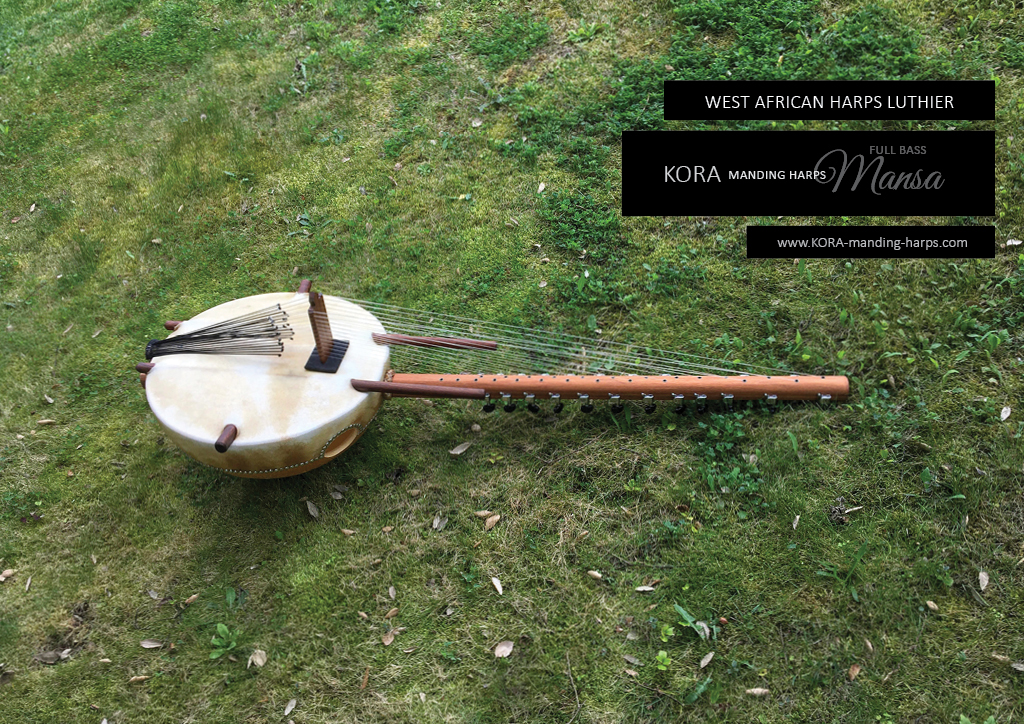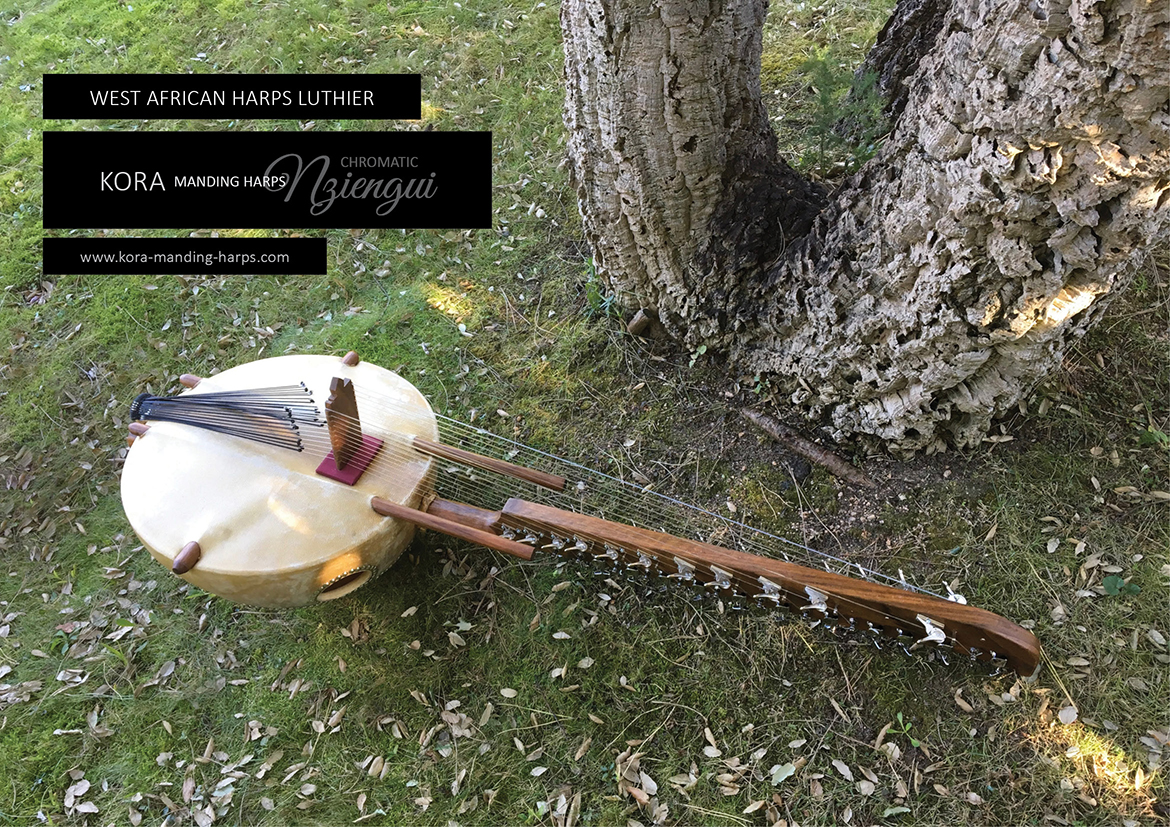STANDARD
Line of koras that follows the parameters of traditional Manding koras: proportions, measurements, adjustments, weights... however, in this model, mechanical pegs (guitar tuners) are used for tuning instead of traditional leather rings (konso), which makes the tuning process of the instrument simpler and faster, making it substantially more practical (it is modernized).
This type of kora is widespread globally and is offered with 21 or 22 strings. It has been played by both beginners and professionals for hundreds of years.
LIGHT TRAVEL
Type of koras that allow the musician to comfortably transport the instrument from one place to another without it becoming a cumbersome burden.
These koras have an optimized size and weight compared to the common standard models... however, for this brand, it is very important that these adaptations of the instruments do not result in a loss of the original sound (characteristic sound of the traditional instrument). Because the design of overly compact and modified travel koras very often changes the proportions, balance, sound, and feedback of the instrument... and the result is then no longer a kora instrument at all.
This model uses less dense woods, the lightest pegs on the market (classical guitar types), and the minimum dimensions without leaving "the zone." And their sound is very kora and very beautiful.
RESONANCE
This model was developed to improve the sound performance of the instrument's soundboard (the membrane) compared to the traditional construction system. It aims to prevent the transmission of vibrations caused by the instrument's handgrips, which block the skin from the inside (back).
The result of liberating the skin is an improvement in the flow of vibration (resonance), which manifests as:
An increase in volume. Longer sustain... especially noticeable in the bass notes. A very natural balance between all octaves. Every note sounds very clear. A gentler flow of vibration through the instrument membrane (soundboard). And nearly zero vibration of the handgrips, which gives a very quiet feedback to the hands while playing.
In summary, all of this conveys a very good feeling when playing, both mechanically and acoustically, thus encouraging spontaneous inspiration.
FULL BASS
This model has all the deep bass note octaves that a standard kora does not have by default. These Full-Bass koras have 24 notes, while standard models have 21 or 22.
This kora is very interesting for giving a deeper feel to any piece (whether traditional or new compositions), because the complete bass line adds "more colors to the palette... to paint new landscapes."
If you are accustomed to standard koras and want to "travel further," these Full-Bass models are a real game-changer... I always say that I would definitely choose a FULL-BASS model before opting for a SEMITONES model, because it makes a really big difference.
The strings are configured in the same way as on a 21 or 22-string kora, so everything you have learned before is not affected. Only 3 or 2 extra bass notes are added at the beginning of the bridge.
Taking a 21-string kora as a reference, with a FULL-BASS model you have the deepest octave of your kora: the 2F... then 2G, 2A, 2B come as added bass notes, which close the gap up to 3C... and the rest of the strings are as usual up to 5A.
SEMITONES
This line of koras, which became known as "chromatic koras" (*), features a system of levers installed on the arch (the long neck). When operated, they press on each string, changing its length. This shifts the desired string up by a semitone.
This is interesting for musicians who frequently need to change the pitch (the repertoire) quickly, smoothly, easily, and, very importantly, stably, since the strings do not go out of tune in the process.
Therefore, they are particularly well suited for live concerts.
Koras with a semitone lever system allow switching between traditional Manding styles typical of the kora and other styles that are further away from the usual repertoire. This is interesting for advanced players, "jazz souls," composers...
The semitone koras are heavier than the standard models because they carry more metal (levers and pins in addition to the tuning pegs) on the arch... and they require special attention to avoid damaging their mechanism (from impacts).
(*) Chromatic means 12 notes ready to be played/combined at any time (like on a piano), and this is never the case with a semitone kora. You can change the notes as often as you like, before and during playing (if you are practiced), but you always only have 7 notes ready to play (a diatonic scale). "Chromatic" is therefore not a correct name for this type of kora, but it "went viral years ago" and many people call it that nowadays.
SKIN FREE
Koras specifically designed for those who do not wish to enjoy a musical instrument made with animal skin... which is why they are sometimes also called "vegan koras." Therefore, in this model, the entire kora is made 100% of wood.
The sound of the bass notes is not as warm as with instruments using skin (as that warmth is only achieved with skin), but they still have an absolute kora sound, and those basses remain interesting because I have worked hard to find the best result... while the mid and high octaves sound quite similar to other koras.
If you prefer not to use animal skin in your instrument, I can tell you that the sound on this model is also beautiful. You will enjoy it and even forget whether it was made from wood or animal skin.
By exchanging animal skin for wood, the instrument's soundboard is more stable against changes in humidity and temperature, which means it detunes less easily.
MCS
This model is a compilation of subtle improvements that, in sum, make a difference... and it is also the result of a long-term analysis of how the instrument configuration and the playing dynamics interact and influence the playing.
The result is an instrument that "not only wants to pull in the same direction as the player but even helps him/her with the execution"...
Contact me to learn more about this or other models.













